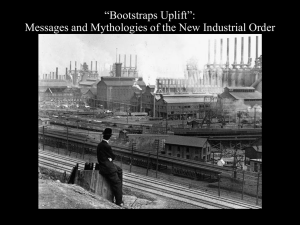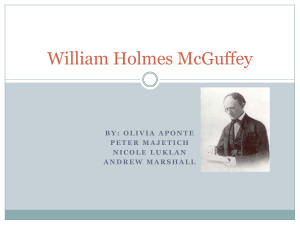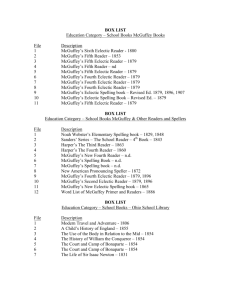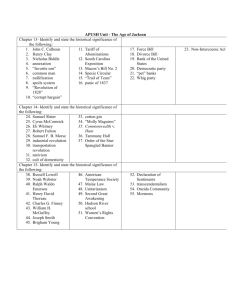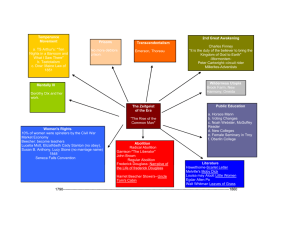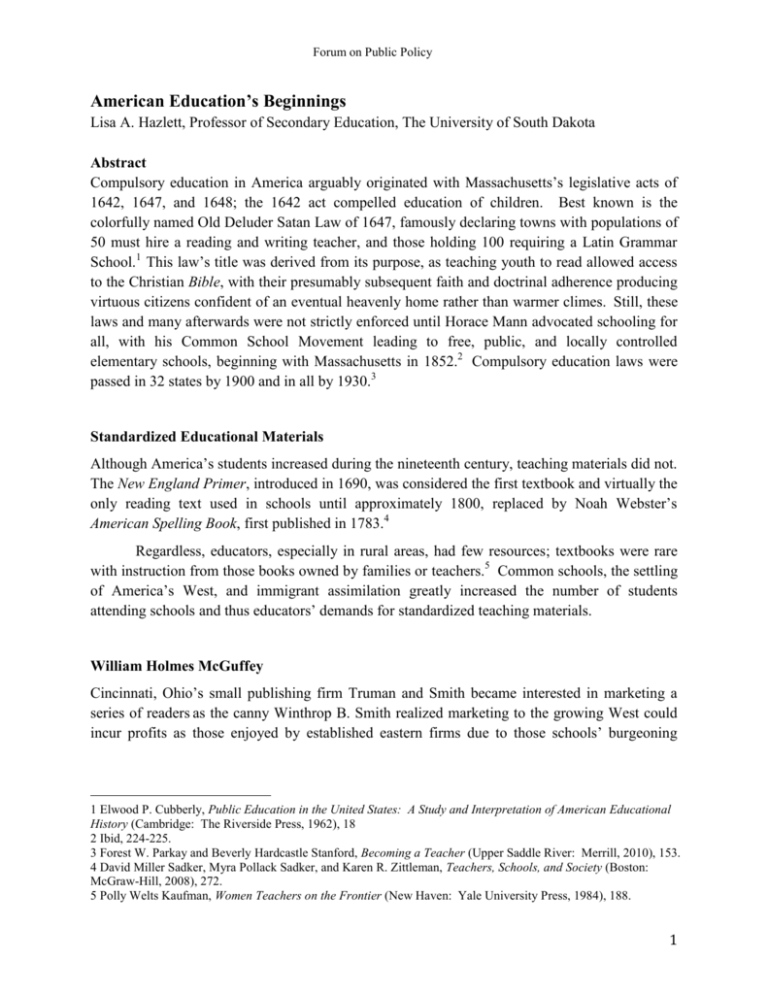
Forum on Public Policy
American Education’s Beginnings
Lisa A. Hazlett, Professor of Secondary Education, The University of South Dakota
Abstract
Compulsory education in America arguably originated with Massachusetts’s legislative acts of
1642, 1647, and 1648; the 1642 act compelled education of children. Best known is the
colorfully named Old Deluder Satan Law of 1647, famously declaring towns with populations of
50 must hire a reading and writing teacher, and those holding 100 requiring a Latin Grammar
School.1 This law’s title was derived from its purpose, as teaching youth to read allowed access
to the Christian Bible, with their presumably subsequent faith and doctrinal adherence producing
virtuous citizens confident of an eventual heavenly home rather than warmer climes. Still, these
laws and many afterwards were not strictly enforced until Horace Mann advocated schooling for
all, with his Common School Movement leading to free, public, and locally controlled
elementary schools, beginning with Massachusetts in 1852.2 Compulsory education laws were
passed in 32 states by 1900 and in all by 1930.3
Standardized Educational Materials
Although America’s students increased during the nineteenth century, teaching materials did not.
The New England Primer, introduced in 1690, was considered the first textbook and virtually the
only reading text used in schools until approximately 1800, replaced by Noah Webster’s
American Spelling Book, first published in 1783.4
Regardless, educators, especially in rural areas, had few resources; textbooks were rare
with instruction from those books owned by families or teachers.5 Common schools, the settling
of America’s West, and immigrant assimilation greatly increased the number of students
attending schools and thus educators’ demands for standardized teaching materials.
William Holmes McGuffey
Cincinnati, Ohio’s small publishing firm Truman and Smith became interested in marketing a
series of readers as the canny Winthrop B. Smith realized marketing to the growing West could
incur profits as those enjoyed by established eastern firms due to those schools’ burgeoning
1 Elwood P. Cubberly, Public Education in the United States: A Study and Interpretation of American Educational
History (Cambridge: The Riverside Press, 1962), 18
2 Ibid, 224-225.
3 Forest W. Parkay and Beverly Hardcastle Stanford, Becoming a Teacher (Upper Saddle River: Merrill, 2010), 153.
4 David Miller Sadker, Myra Pollack Sadker, and Karen R. Zittleman, Teachers, Schools, and Society (Boston:
McGraw-Hill, 2008), 272.
5 Polly Welts Kaufman, Women Teachers on the Frontier (New Haven: Yale University Press, 1984), 188.
1
Forum on Public Policy
enrollments.6 Moreover, books supplying curricula and imparting then-contemporary American
beliefs and values to children in these new communities and recent immigrants were especially
needed.7
William Holmes McGuffey, an Ohio professor and Presbyterian minister, had already
begun work on his own readers when contracting with Truman and Smith to complete a primer,
four readers, and a speller. His Eclectic First Reader and Eclectic Second Reader were published
in 1836, followed by the Third and Fourth in 1837. McGuffey’s brother wrote the Fifth Reader
in 1844, a Spelling Book in 1846, and a Sixth Reader in 1857.8 The term “eclectic” referred to
the books’ reading selections chosen from a wide variety of sources.
McGuffey’s Readers
Between 1836 and 1890, McGuffey’s sold over one hundred million copies, resulting in
practically every American child who attended public schools during the second half of the
nineteenth century using them.9 They were serialized by grade levels, featured then uncommon
illustrations, and defined vocabulary words within a piece’s context. More importantly, they
provided the country with a common knowledge base and worldview through their stories and
exercises that illustrated the societal and moral standards expected of children at that time.10
Stories were Calvinist leaning, reflecting personal independence, character, honesty, and
decency. Strong moral conclusions were presented, usually by contrasting positive and negative
actions of children and resultant consequences. Biblical verses and doctrine frequently appeared
separately and within selections.
Accompanying assignments and other instruction, although meager compared to
contemporary texts, focused upon improving spelling and vocabulary knowledge, and creating
effective public speakers through speaking. Doubtless, the era’s increase of immigrants made
such lessons doubly important.
The Readers, meant for students in grades one through six, varied in length difficulty,
and overall theme. The Primer and Pictorial Primer11 began with the alphabet and moved to
simple one-syllable words, with the latter including simple three- and four-word sentences,
ending with longer sentences and full paragraphs. Their contemporary audience appears closest
to the first grade.
6 Henry H. Vail, A History of McGuffey’s Readers (Project Gutenberg, 2005), accessed April 27, 2011, 16,
http://www.gutenberg.org/files/15577/15577-h/15577-h.htm.pdf
7 Henry H. Vail, A History of McGuffey’s Readers (Project Gutenberg, 2005), accessed April 27, 2011, 16,
http://www.gutenberg.org/files/15577/15577-h/15577-h.htm.pdf
8 Henry H. Vail, A History of McGuffey’s Readers, 15-17.
9 Ibid., 29.
10 Henry Steele Commager, introduction to McGuffey’s Sixth Eclectic Reader, x-xi.
11 Henry H. Vail, A History of McGuffey’s Readers, 15.
2
Forum on Public Policy
The First Reader 12 introduced McGuffey’s moral code through stories depicting children
who loved learning and God, proper and improper conduct, and respective consequences.
Lessons were progressively difficult, and seem suitable for today’s second grades. The Second
Reader 13 featured lessons from more subjects, multi-syllabic words, and especially stressed
youths’ proper attitudes and duties. Today’s audience approximates grades three to five.
The Third Reader14 was more formal and difficult, largely focusing upon rules for oral
reading, and fitting contemporary grades six to eight. Introducing quality or canonical literature
and emphasizing thinking skills was the Fourth Reader’s 15 purpose, and it contained deeper
discussions of such topics as education, God, religion, and philosophy. Its difficulty level
appears equivalent to modern upper level junior high or high school students.
McGuffey’s younger brother added a Rhetorical Guide, later developed into the Fifth and
Sixth Readers,16 with the Fifth containing canonical selections and elocutionary exercises, and
the Sixth stressing composition; all appear equivalent to contemporary high school students’. A
Progressive Speller 17 was also included, which began with basic phonics and progressed to
advanced vocabulary.
McGuffey’s publishing contract dissolved in 1841, with his input into further editions
ceasing after 1845, although his name was added to all successive versions. Subsequent editions
continued their moral tone and religious doctrine while gradually softening the often frightening,
harsh stories to suit societal needs over passing years. The most popular edition was published
in 1879, six years after McGuffey’s death and used by public schools throughout 1920,18 and
undoubtedly beyond in some areas.
Contemporary Availability of McGuffey’s Readers
Facsimiles of the 1836 versions are easily available from various bookstores and the Internet;19
individual Revised Readers may be downloaded for a Kindle© or other like devices for a small
fee.20 Originals naturally vary in price and condition, but the entire revised 1879 collection may
be downloaded or read free of charge from numerous online sources, including the contemporary
Internet sites Project Gutenberg, McGuffey’s Readers World, or The McGuffey Readers.
12 Ibid., 5.
13 Ibid., 5.
14 Ibid., 5
15 Ibid, 5.
16 Ibid, 5.
17 Ibid, 5.
18 Ibid, 5.
19 Lamp Post Homeschool Store. 2011. “McGuffey’s Eclectic Readers.” Accessed February 9.
http://www.lamppostpublishing.com/mcguffeys-readers.htm.
20 Amazon.com. 2011. “McGuffey’s Eclectic Readers.” Accessed February 20.
http://www.amazon.com/s/ref=nb_sb_ss_i_l_27?url=search-alias=st .
3
Forum on Public Policy
Homeschooling and Christian Fundamentalism
While McGuffey’s Readers are no longer used in public schools, fundamentalist Christians who
home school their children have rediscovered them. The Cato Institute essentially defined
homeschooling as educating school-aged children at home rather than at public or private
schools, 21 and The National Center for Educational Statistics (NCES) reported approximately
three-quarters of those homeschooling self-identified as conservative/fundamentalist
Christians.22
Fundamentalism is based upon belief of the Christian Bible’s inerrancy and thus its literal
interpretation, the necessity of a conversion experience through faith in Jesus Christ alone, (a.k.a.
being “born again”), and Christ’s return to earth (a.k.a. the “second coming”).23 As with all
religious denominations or groups, individuals’ beliefs and adherence regarding doctrinal points
vary. Regardless, fundamentalists’ repeatedly state central reasons for homeschooling are to
provide religious and moral instruction believed lacking within public schools’ atmosphere and
practices.24
While fundamentalism can be defined, homeschooling is less distinct. The Tenth
Amendment of the United States Constitution declares that not delegated to the federal
government becomes state purview; public education is thus designated to individual states’
control. Although homeschooling has always occurred, fundamentalists’ efforts for its
legalization in all states and Washington, D.C. began during the 1960s and was achieved in
1993.25 While homeschooling overall is unique to each state, all homeschooled children must
demonstrate state-mandated general knowledge and achievement scores equivalent to public
school students’.26
McGuffey’s Readers and Fundamentalist Homeschooling
Thousands of fundamentalist Internet sites are devoted to homeschooling; some prominent ones
include Families.com, Conservative Homeschoolers, Homeschoolspot, Homeschooling Today,
Homeschool.com, Home School Legal Defense Association (HSLDA), Home Education
Magazine, Homeschoolchristian.com, and ChristianHomeschoolers.com.
McGuffey’s Revised Readers are promoted or featured on these and similar online
homeschooling sites, with many, including Eclectic Homeschool Online, Dollar Homeschool,
21 Lyman, Isabel. 1998. “Homeschooling: Back to the future?” Cato Policy Analysis No. 294. Accessed February
11. http://www.cato.org/pubs/pas/pa-294.html.
22 Homeschooling in the United States: 2003-Executive Summary. 2006. National Center for Education Statistics.
Accessed February 2. http://www.nces.ed. gov/pubs2006/homeschool/.
23 Wacker, Grant. 2000. “The Christian Right.” National Humanities Center. Accessed February 5.
http://www.nationalhumanitiescenter.org/tserve/twenty/tkey info/chr_rght.htm.
24 “Homeschooling in the United States: 2003-Executive Summary.”
25 Wacker, “The Christian Right.”
26 “Homeschooling in the United States: 2003-Executive Summary.”
4
Forum on Public Policy
and Mott Media, LLC, solely devoted to them. Likewise, a myriad of teaching instructions,
supplemental activities, resources, teaching guides, and other accompanying materials for the
Readers are available online, as are communication methods that allow McGuffey users a forum
for discussions, questions, and ideas regarding application.
The Readers are recommended for teaching reading and the English language arts due to
emphases upon traditional Christian morals, values, and beliefs, biblical use, canonical classic
readings, phonics, rote memorization, and direct teaching styles.27 Specifically, the texts do not
contain “secular humanism,” fundamentalists’ term for any set of beliefs that promote human
values without specific allusion to religious doctrine.
Secular humanism is a central but often ephemeral reason for fundamentalists’ aversion
to public schools and cited as rationale for book challenges, complaints of texts, materials, and
educators’ teaching, requests for overt use and display of Christian doctrine, school prayer and
student prayer groups, criticism regarding Christmas, Halloween, and other holiday practices or
pageants, and any other items or practices inharmonious with this groups’ beliefs.28
McGuffey’s Readers’ Fundamentalist and Educational Divergences
Contemporary reviews of the Readers feature many aspects opposed to Christianity in general
and fundamentalism specifically, as well as espousing poor teaching techniques. These
detractions are glaring, consistent throughout the Readers, yet, aside from individuals’ comments
on Internet message boards or blogs, unmentioned by fundamentalist homeschooling
organizations. The most significant digressions are examined below, with all representative
examples from the 1879, and most popular for fundamentalists’ homeschooling, versions.
Educational and Fundamentalist Discrepancies within McGuffey’s Readers
Morality is Materialistically and Fantastically Rewarded Non-Commensurate to
the Action, with Virtue Seldom its Own Reward
Christianity espouses goodness throughout the Bible without expectation of earthly reward, but
the Readers’ proliferate with small deeds reaping huge, usually unbelievable, benefits.
Examples include the First Reader’s “The Little Loaf,”29 showing a rich baker offering poor
children bread loaves. While the boys fight for the largest, a girl is content with the smallest and
thanks the man. Upon slicing the bread, shiny silver coins appear, saving her family from abject
poverty.
27 Dollar Homeschool. 2011. “Eclectic Education Series: McGuffey’s Readers.” Accessed February 9.
http://www.dollarhomeschool.com/readersandgrammar/index.html
28 Allen Pace Nilsen and Kenneth L. Donelson, Literature for Today’s Young Adults, (Boston: Pearson), 398
29 William Holmes McGuffey, “The Little Loaf,” in McGuffey’s First Eclectic Reader (Project Gutenberg, 2005),
172-174,
http://onlinebooks.library.upenn.edu/webbin/gutbook/author?name=McGuffey%2C%20William%20Holmes%2C%
201800-1873
5
Forum on Public Policy
“Respect for the Sabbath Rewarded”30 finds William, a barber uncomfortable working on
the Sabbath, attending church instead. This leads to his business loss and utter ruin, until a
stranger appears and William uses his last candle to provide a shave. The stranger was seeking
William, soon to become heir to an immense fortune.
Impact: Repeated subjection to extraordinary rewards doubtless causes children’s
eventual expectations of them, creating environments of greed and materialism. Students
quickly want rewards for completing various assignments, projects, and other tasks; grades
themselves are unsatisfactory. Society is full of such examples, including fundamentalist and
secular financial scandals, with America’s present economy a telling illustration.
Moreover, the redundancy of this plot throughout all Readers quickly causes uninterest,
unimaginativeness, and ineffectiveness among students and instructors; worse, unvarying stories
frequently results in like teaching, with ultimate development of critical thinking skills stalled.
An Immediate Punishment System is Demonstrated; Negative Behaviors are
Punished Harshly, with Single Experiences Transformative
Unlike real life, where individuals’ negative behaviors may be undetected or ignored, in
McGuffey’s actions are immediately judged. “Harry and Annie” 31 were forbidden to cross a
frozen pond while walking to school; disobeying, they fell in the freezing water. Both were
rescued, but lesson learned.
Likewise, “The Truant” 32 has James skipping school and lying to his parents upon
returning home. Skipping again, he hired a boat and a great storm suddenly appeared, throwing
him into the churning water. Saved just before drowning, James became a model student.
Impact: Children learn to listen only to others, not themselves, as their choices are
inherently bad or wrong and bring disastrous results. Condemnation, not compassion, results
from wrongdoing, ultimately developing simplistic worldviews. Long-standing behaviors
changed after a single incident, even a harrowing one, is unlikely, perhaps more so today, and
idealized.
Real children continually make mistakes, often the same repeatedly; continual instruction
and assistance from caring adults’ shapes behavior over time rather than single incidents. While
McGuffey’s characters’ poor behaviors are immediately punished, unmentioned are children
who continually misbehave, or those profiting from their actions.
By depicting right and wrong via absolutes rather than providing questioning or gray
30 William Holmes McGuffey, “Respect for the Sabbath Rewarded,” in McGuffey’s Fifth Eclectic Reader (Project
Gutenberg, 2005), 69-71, 671http://onlinebooks.library.upenn.edu/webbin/gutbook/author?name=
McGuffey%2C%20William%20Holmes%2C%201800-1873.
31 William Holmes McGuffey, “Harry and Annie,” in McGuffey’s Third Eclectic Reader (Project Gutenberg, 2005),
46-48,
http://onlinebooks.library.upenn.edu/webbin/gutbook/author?name=McGuffey%2C%20William%20Holmes%2C%
201800-1873.
32 Ibid., 27-29.
6
Forum on Public Policy
areas in between, students’ critical thinking skills regarding their own selves remain undeveloped,
meaning individuals will likely believe and follow others, especially authority figures, regardless
of appropriateness. This produces sycophantic followers, and repressed individuals, not societal
leaders.
Stories Frequently Show Children Haunted by Negative Actions, Often Single
Ones, for Entire Lives Without Forgiveness
“The Insolent Boy”33 shows a boy who is physically cruel, brutally attacking a shabby
man he encounters. Upon returning home, he discovers the man is his rich uncle, bearing a gold
watch for him. The boy’s remorse cures his cruelty, but remains unbearable throughout his life.
Similarly, “My Mother’s Grave”34 features a girl recalcitrant regarding bringing water to her ill
mother, finally doing so grudgingly. Upon discovering her mother died during the night, she
changed her behavior, but forever mourned that her mother’s last memory was of her uncaring.
Impact:Children are not allowed to act as children; perfection is expected with minor
faults overly magnified, causing exaggerated regrets, pain, and remaining perhaps forever.
Because only perfection is demonstrated, children cannot so emulate and may cease improving
behavior completely, failing to learn coping and social skills for ordinary issues or problems.
Those without such skills do not meld well into society’s many structured situations, with
personal pain causing depression and other like debilitating illnesses.
Many Stories Make No Age Concessions, and Show Little Effort to be
Entertaining; the Message, not Presentation, is Key. Messages Regarding
Conduct are Provided Through Fear
“The Noblest Revenge”35 follows a boy pulling off a bee’s wings for fun, being stung, striking
the hive in anger, and then stung by the hive until near death, after which he repents and ceases
all negative acts. “The Venomous Worm”36 describes a reptilian worm:
The symptoms of its bite are terrible. The eyes of the patient become red and
fiery, his tongue swells to an immoderate size, and obstructs his utterance; and
delirium of the most horrid character quickly follows. Sometimes, in his madness,
he attempts the destruction of his nearest friends..37
However, the so-called worm is a description of one who drinks alcohol.
33 Ibid., 158-162.
34 William Holmes McGuffey, “My Mother’s Grave,” in McGuffey’s Fourth Eclectic Reader (Project Gutenberg,
2005), 253-255,
http://onlinebooks.library.upenn.edu/webbin/gutbook/author?name=McGuffey%2C%20William%20Holmes%2C%
201800-1873
35 Ibid., 94-97.
36 William Holmes McGuffey, “The Venomous Worm,” in McGuffey’s Fifth Eclectic Reader, 77-78.
37 Ibid., 77.
7
Forum on Public Policy
Impact: Teaching through fear may overly frighten some children to the point of
nightmares or worse, such as panicking upon being alone, extreme shyness, or introversion. Fear
may cease the young’s negative behaviors, but becomes ineffective when children are no longer
frightened; a venomous worm is scary for youngsters, not necessarily older children. Moreover,
fear garners resentment rather than respect; once youth overcome initial fears, they lose trust and
respect for personal authority figures.
Aside from squandering productive teaching opportunities and perhaps causing personal
illnesses as above, such harshness may also lead those being taught to rebel or renounce family
beliefs and views.
Ominous Messages Allude to Children Always Being Watched and Thoughts
Known, with Implications of Imperfections Removing Love
One chilling warning is a First Reader statement, “If you are good, and if you try to learn, your
teacher will love you, and you will please your parents,” 38 and a reminder from The Third
Reader is “…Remember, if no one else sees you, God does, from whom you can not hide even
your most secret thought.”39
Impact: Absolute perfection is impossible, and children’s mistakes will make them
doubly frightened, believing removal of parental or other love, along with God’s—who might
send them to hell, an especially frightening prospect for the more devout original readers and
contemporary fundamentalists’. Fear often results in poor self-confidence, and children may
focus on and produce extremely small products and ideas, remaining only with that which they
know to be safe in order not to make mistakes. Fear of imperfection will never allow children to
take the risks that produce growth and greatness in life.
There is Forgiveness for Some, but Not All
Naturally, those engaged in negative actions are necessary antagonists, but they are not given the
same opportunity as protagonists’ to change behaviors in stories. “Charlie and Rob”4040 details a
discussion between a lazy boy and a hard worker; the ending shows the worker as rich and the
other a tramp before age 30.
“A Walk in the Garden”4141 describes Frank and his mother invited to walk in a lovely
garden, and asked to take care with its greenery. Another boy asks to enter the garden’s gates,
but is refused because he previously meddled with the plants. Upon leaving, Frank is rewarded
with lovely flowers.
Impact: Aside from Christianity’s doctrine of forgiveness, seeing some children not
afforded absolution is doubtless frightening and confusing. If children cannot be forgiven or
38 William Holmes McGuffey, “Lesson LXIII” in McGuffey’s First Eclectic Reader (Project Gutenberg, 2005), 94.
39 William Holmes McGuffey, “Things to Remember” in McGuffey’s Third Eclectic Reader, 66.
40 Ibid., 104-107.
41 Ibid., 39-41.
8
Forum on Public Policy
given second chances, their fears over any transgression must be horrific. Such children may
feel frightened, hopeless, engage in new, or continue, negative behaviors, and begin selffulfilling prophecies that will undoubtedly become true, needlessly.
As above, subservience from fear stunts intellectual growth and curiosity; children will
do only what is assigned, never more lest possible incorrectness would lead to censure or worse.
As above, those unwilling to progress past certain points will never excel, lessening success in
all areas of life.
The Readers’ Contain Numerous Death-Themed Stories, Requiring Children to
Baldly Contemplate Death
“A Home Scene”42 describes a small boy in his comfortable home—with every stanza
emphasizing his unawareness of death until the final two, when he suddenly matures by realizing
death comes to all. An especially morbid story, “We are Seven,”43 features a girl who eerily
refuses to refer to her two dead siblings as such, continuing to spend nearly as much time at their
graves as if they were alive and conversing with them.
Likewise, the classical selections in the Fifth and Sixth Readers by renowned authors
overwhelmingly feature grim, death-related stories rather than choices from their many other
lighter, and presumably as or more meaningful, works. Notable examples from the Fifth Reader
include Longfellow’s “The Reaper and the Flowers,” 44Bryant’s like-themed “The Death of the
Flowers,”45 and Thomas Hood’s “Faithless Nelly Gray.”46
Some entries from the Sixth Reader include Dickens’s “Death of Little Nell,”47 Gray’s “Elegy in
a Country Churchyard,”48 and Irving’s “Sorrow for the Dead.”49
Impact: Children and youth repeatedly reading stories about death would doubtless feel
fearful or morbid, finding it difficult to enjoy the present, and when a death does occur, become
challenged to move forward and continue living productive, enjoyable lives. Children of
contemporary society, with its emphases upon Goth culture, suicides, school shootings, darker
media and video, video games, etc., are perhaps more at risk than yesterday’s, with their instant
access and knowledge of these items and events.
Moreover, some can become increasingly fearful and didactic, expressing inappropriate
warnings and concerns to others or enacting such behaviors, thus halting or limiting activities
and challenges regarding their education and later life. As with the above reward stories, topic
redundancy causes uninterestedness, ineffectiveness, unimaginativeness, and the stalling of
42 William Holmes McGuffey, “A Home Scene” in McGuffey’s Fifth Eclectic Reader, 292-294
43 William Holmes McGuffey, “We are Seven” in McGuffey’s Third Eclectic Reader, 163-166.
44 Henry Wadsworth Longfellow, “The Reaper and the Flowers” in McGuffey’s Fifth Eclectic Reader, 113-114.
45 William Cullen Bryant, “The Death of the Flowers” in McGuffey’s Fifth Eclectic Reader, 129-131.
46 Thomas Hood, “Faithless Nelly Gray” in McGuffey’s Fifth Eclectic Reader, 155-157.
47 Charles Dickens, “Death of Little Nell” in McGuffey’s Sixth Eclectic Reader, 112-116.
48 Thomas Gray, “Elegy in a Country Churchyard.” in McGuffey’s Sixth Eclectic Reader, 124-131.
49 Washington Irving, “Sorrow for the Dead.” in McGuffey’s Sixth Eclectic Reader, 271-273.
9
Forum on Public Policy
growth.
Anthropomorphization in Stories
Fundamentalists fight virulent censorship battles to ban those books in which animals or
other
non-humans
speak
or
otherwise
exhibit
human
characteristics,
e.g
50
“anthropomorphization.” Still, the Readers are full of such stories, as the “The Wind and the
Sun,”51 showing the two debating which is stronger, or a story from the First Reader showing a
hen taking her chickens to a small brook for fresh air and sunshine.52
Impact: If fundamentalists’ find anthropomorphization unacceptable in trade literature,53
it seems hypocritical to accept it in McGuffey’s. However, if so, adults should re-evaluate their
views against this universal technique that is especially enjoyable to children, allows imagination,
further identification and understanding of emotions and actions, and assists in development of
critical thinking skills.
Imagination is especially crucial to education and lifetime skills; as with those stories
containing fearful aspects, a steady diet could produce those unable, or unwilling, to contribute
or create new ideas and items. As above, this group, if unable to reach their potential or greatness,
will doubtless be passed over for those who can.
Although the Readers Were Compiled During America’s Period of Great
Reform, They Reflect No New Inventions, Question Existing Ideas or
Institutions, or Consider Concepts of Social or Political Responsibility
Impact: Opposite from contemporary politicians courting fundamentalists’ to change
societal views and laws—abortion, homosexual marriage, school prayer, sex education,
etc.—the Readers contain neither discussion of then-current events nor comparative models for
effective, respectful change.
Fundamentalists as a whole are associated with intolerance and hatred, especially by the
public presence and voice concerning above topics by some, flamed by imposition of views and
demands without using skills to listen and negotiate. Students must learn of current world events,
discuss, compare and contrast them, becoming knowledgeable of their various facts and fictions.
Those fed a diet of partial, prescribed, or sanitized facts may never be able to process
complete information regarding certain items. Those unable or unwilling to accept all topic
facets will have little to contribute among those with differing beliefs; such stoics either face a
lifetime with only those sharing identical views or combative, uncomfortable relationships’ with
others, hardly desirable societal characteristics. Moreover, those with such limited views are
likely to face frequent opposition, making many more unlikely to consider other views or
practice positive aspects of effecting societal or other change, again limiting growth.
50 Alleen Pace Nilsen and Kenneth L. Donelson, Literature for Today’s Young Adults, 407.
51 William Holmes McGuffey, “The Wind and the Sun” in McGuffey’s Third Eclectic Reader, 59-60.
52 William Holmes McGuffey, “Lesson LXI” in McGuffey’s First Eclectic Reader (Project Gutenberg, 2005), 88-92.
53 Alleen Pace Nilsen and Kenneth L. Donelson, Literature for Today’s Young Adults, 401.
10
Forum on Public Policy
While Read by American children, Readers Omit Many Important American
People and Events of the Era
Impact: Fundamentalists’ promote McGuffey’s due to their distinctly “American” values,
views, and beliefs. However, aside from later canonical works, the stories have no particular
sense of place or people. For example, the Civil War is barely mentioned, as are Thomas
Jefferson, Abraham Lincoln, or Mark Twain. The California Gold Rush and
Oregon Trail, which helped create the need for these readers, are also unmentioned.54
Those intending to use the Readers to promote American patriotism, a strong fundamentalist
value, will require supplementation, lest producing adults ignorant of basic American history, or
holding biases.
Many of the Readers’ Works are from or About Non-American Authors and
Countries. However, Few Significant Cultural Comparisons are Made
Impact: As with anthropomorphization, fundamentalists have and continue to be highly
critical of multiculturalism/diversity, challenging books containing non-American information
and like writers.55 Many canonical authors and stories are included in the Readers that would
doubtless be challenged in public school anthologies. Aside from being hypocritical, students
are not given a view of the world that allows understanding, sympathy, or empathy toward
others’, hardly beneficial to later success or personal happiness in any venue.
McGuffey’s Reflects No Conscious Concession of Children’s Learning Needs,
Assuming Understanding of Material
Impact: Because contemporary estimations place the Readers at higher-grade levels than
originally intended, today’s students will be using texts meant for younger students, possibly
lessening interest, story identification, and motivation. Written during a past era, the series
obviously does not contain modern helps (graphics, glossary, words defined in the margins, etc.)
found in contemporary texts.
Likewise, corresponding assignments are sparse, difficult, essentially identical
throughout the readers, and rely upon rote memorization or questions asking for information
contained in the story; student creativity or development of questioning and thinking skills are
not developed through such activities.
Supplemental materials for comprehension assistance and enticing yet productive
activities, projects, quizzes, tests are necessary or helpful for any text, but especially for these
Victorian Readers. It is assumed contemporary students can learn from them, but using as
teaching tools may require far more time and effort than first supposed, with the creation of
54 Henry Steele Commager, introduction to McGuffey’s Sixth Eclectic Reader, xi.
55 Alleen Pace Nilsen and Kenneth L. Donelson, Literature for Today’s Young Adults, 401.
11
Forum on Public Policy
supplemental helps more extensive, for some. Depending upon those taught, educators might
find themselves rewriting or otherwise revising large sections for understanding, thus
undermining the use and effectiveness of the original texts.
McGuffey’s Readers as Contemporary Teaching Tools
Students are asked to learn using texts from the past, not about the past; McGuffey’s were
intended for children of a bygone era. Today’s students hardly live in the Readers’ Victoria, and
as their lives and situations are not mirrored in their entries, productive learning appears dubious.
The Readers look and sound essentially the same throughout, with their main difference
larger fonts and illustrations for youngest readers. While one volume is interesting for its quaint
pictures, stories, and historical value, how long the basically identical content of the entire series’
and their activities will engage curious, modern students is questionable. It is also assumed that
students’ will enjoy and want to learn from these readers, doubtless false for some.
Fear of change seems the central rationale for fundamentalists’ using McGuffey’s
Readers for homeschooling. Most people presumably dislike society’s disturbing or unsettling
elements, but society as a whole cannot necessarily be changed. Television, the Internet, movies,
music, video games, teen pregnancies, school shootings, the economy—such items are
encountered by all, especially children, and fears of this long list vary by individual.
Because one cannot change society, one seeks what can be changed—that section of
society immediately concerning individuals and their families. As schools teach students each
day, they naturally become a focus for those with minority views. Fundamentalists and others
fight for various changes within schools, but schools cannot personalize teaching to fit the needs
and desires of every family, regardless of alterations made.
Those homeschooling undoubtedly feel their children will be irrevocably changed for the
worse by public schools’ curricula, methodologies, and population that differ from family beliefs
and behaviors. Homeschooling is a reaction to that fear, presumably a way of keeping children
safe from schools’, which mirror society, negative influences.
Fundamentalist McGuffey’s users doubtless believe the series’ morals, biblical use and
doctrine, paternalistic families, separate gender roles, powerful illustrations regarding children’s
proper behavior, stories absent of contemporary situations considered offensive, and language
free of profanity or otherwise troubling terminology, is a way of reclaiming their way of life. It
is also a return to the past, when things were deemed “simpler,” “safer,” or “easier,” and “oldfashioned values” were upheld, unlike today.
This is not strictly true, of course, but the past is always viewed nostalgically, through
rose-colored glasses, and McGuffey’s provides such imagined safeness and ease without either
contemporary society’s problems or Victorian brutal realities. Still, there is a difference between
education, i.e., teaching children to think, question, and reflect about ideas, actions, and
consequences, and indoctrination, i.e., teaching children selectively, omitting controversial
12
Forum on Public Policy
material, and discouraging questioning of items considered inappropriate by adults. Every child
should be taught to be culturally literature, compassionate, sympathetic, empathetic, and socially
aware.
All children deserve to be educated, but fundamentalists’ using McGuffey’s Readers to
home school contemporary youth seem to be making an age-old mistake: looking behind for
teaching resources that will erase the intimidating transformations of the present and future while
still providing students with modern, challenging curricula.
While McGuffey’s Readers accomplished much in the past, there they should remain;
education must prepare students, regardless of belief, for the future in which all will be living.
The Series’ deserves to be celebrated rather than used as teaching tools, as their current
educational and personal benefits appear more detrimental than effective regarding contemporary
students’
Bibliography
Amazon.com. “McGuffey’s Eclectic Readers.” Accessed February 20, 2011,
http://www.amazon.com/s/ref=nb_sb_ss_i_l_27?url=search-alias=st . . . .
Bryant, William Cullen. “The Death of the Flowers.” in McGuffey’s Fifth Eclectic Reader. New York: Signet,
1962), 129-131.
ChristianHomeschoolers.Com. Accessed January 6, 2011, http://christianhomeschoolers.com/.
Commager, Henry Steele. Introduction to McGuffey’s Sixth Eclectic Reader, by William Holmes McGuffey. New
York: Signet, 1962.
Conservative Homeschoolers. Accessed January 1, 2011,http://freedomtoschool.proboards.com/index.cgl.
Cubberly, Elwood P. Public Education in the United States: A Study and Interpretation of American Educational
History. Cambridge: The Riverside Press, 1962.
Dickens, Charles. “Death of Little Nell.” in McGuffey’s Sixth Eclectic Reader. New York: Signet, 1963), 112-116.
Dollar Homeschool. “Eclectic Education Series: McGuffey’s Readers.” Accessed February 9, 2011,
http://www.dollarhomeschool.com/readersand grammar/index.html.
Eclectic Homeschool Online. Accessed February 2, 2011, http://eclectichomeschool.org/.
Families.com. Accessed January 21, 2011, http://homeschooling.families.com/blog/.
Gray, Thomas. “Elegy in a Country Churchyard.” in McGuffey’s Sixth Eclectic Reader. New York: Signet, 1963),
124-131.
HomeschoolChristian.com. Accessed January 5, 2011, http://www.homeschoolchristian.com/.
Homeschool.com. Accessed January 5, 2011, http://www.homeschool.com/.
Home Education Magazine. Accessed January 2, 2011, http://homeedmag.com/.
Home School Legal Defense Association. Accessed February 1, 2011, http://www.hslda.org/.
Hood, Thomas. “Faithless Nelly Gray.” in McGuffey’s Fifth Eclectic Reader. New York: Signet, 1962), 155-157.
Irving, Washington. “Sorrow for the Dead.” in McGuffey’s Sixth Eclectic Reader. New York: Signet, 1963), 271273.
Kaufman, Polly Welts. Women Teachers on the Frontier. New Haven: Yale University Press, 1984.
Lamp Post Homeschool Store. Accessed February 9, 2011. http://wwww.
lamppostpublishing.com/mcguffeys-readers.htm.
Longfellow, Henry Wadsworth. “The Reaper and the Flowers.” in McGuffey’s Fifth Eclectic Reader. New York:
Signet, 1962), 113-114.
Lyman, Isabel. “Homeschooling: Back to the future?” Cato Policy Analysis No. 294,
http://www.cato.org/pubs/pas/pa-294.html, 1998.
The McGuffey’s Readers. Accessed January 2, 2011, http://www.nd.edu/~rbarger/www7/mcguffey.html.
McGuffey’s Readers World. Accessed January 20, 2011, http://www.mcguffeyreaders.com/
McGuffey, William Holmes. “Lesson LXI.” in McGuffey’s First Eclectic Reader. Project Gutenberg, 2005,
http://onlinebooks.library.upenn.
13
Forum on Public Policy
edu/webbin/gutbook/author?name=McGuffey%2C%20William%20 Holmes%2C%201800-1873.
—. “Lesson LXIII.” in McGuffey’s First Eclectic Reader. Project Gutenberg, 2005,
http://onlinebooks.library.upenn.edu/webbin/gutbook/author?name=McGuffey%2
C%20William%20Holmes%2C%201800-1873.
—. “The Little Loaf.” in McGuffey’s First Eclectic Reader, 172-174. Project Gutenberg, 2005,
http://onlinebooks.library.upennedu/webbin/gutbook/author?name=
McGuffey%2C%20William%20Holmes%2C%201800-1873.
—. “Harry and Annie.” in McGuffey’s Third Eclectic Reader. Project Gutenberg, 2005,
http://onlinebooks.library.upenn.edu/webbin/gutbook/author?name=McGuffey%2
C%20William%20Holmes%2C%201800-1873.
—. “Things to Remember.” in McGuffey’s Third Eclectic Reader. Project Gutenberg, 2005,
http://onlinebooks.library.upenn.edu/webbin/gutbook/author?name=
McGuffey%2C%20William%20Holmes%2C%201800-1873.
—. “We are Seven.” in McGuffey’s Third Eclectic Reader. Project Gutenberg, 2005,
http://onlinebooks.library.upenn.edu/webbin/gutbook/author?name=McGuffey
%2C%20William%20Holmes%2C%201800-1873.
—. “The Wind and the Sun.” in McGuffey’s Third Eclectic Reader. Project Gutenberg,
2005http://onlinebooks.library.upenn.edu/webbin/gutbook/author?nameMcGuff%
2C%20William%20Holmes%2C%201800-1873.
—.“My Mother’s Grave.” in McGuffey’s Fourth Eclectic Reader. Project Gutenberg, 2005,
http://onlinebooks.library.upenn.edu/webbin/gutbook/author?name=
McGuffey%2C%20William%20Holmes%2C%201800-1873.
—. “A Home Scene.” in McGuffey’s Fifth Eclectic Reader. Project Gutenberg, 2005,
http://onlinebooks.library.upenn.edu/webbin/gutbook/author?name=
McGuffey%2C%20William%20Holmes%2C%201800-1873.
—. “Respect for the Sabbath Rewarded.” in McGuffey’s Fifth Eclectic Reader. Project Gutenberg, 2005,
http://onlinebooks.library.upenn.edu/webbin/gutbook/author?
name=McGuffey%2C%20William%20Holmes%2C %201800-1873.
—. “The Venomous Worm.” in McGuffey’s Fifth Eclectic Reader. Project Gutenberg, 2005,
http://onlinebooks.library.upenn.edu/webbin/gutbook/author?name=
McGuffey%2C%20William%20Holmes%2C%201800-1873.
Mott Media, LLC. Accessed February 2, 2011, http://www.mottmedia.com/.
National Center for Education Statistics. “Homeschooling in the United States: 2003-Executive Summary.”
Accessed February 2, 2011, http://www.nces.ed.gov/pubs 2006/homeschool/.
Nilsen, Alleen Pace, and Kenneth L. Donelson. Literature for Today’s Young Adults. Boston: Pearson, 2009.
Parkay, Forrest W., and Beverly Hardcastle Stanford. Becoming a Teacher. Upper Saddle River: Merrill, 2010.
Project Gutenberg. Accessed January 2, 2011, http://www.gutenberg.org/ebooks/search/.
Sadker, David Miller, Myra Pollack Sadker, and Karen R. Zittleman. Teachers, Schools, and Society. Boston:
McGraw-Hill, 2008.
Vail, Henry H. A History of McGuffey’s Readers. Project Gutenberg, 2005.
http://www.gutenberg.org/files/15577/15577-h/15577-h.htm.pdf.
http://www.gutenberg.org/ebooks/search/.
Wacker, Grant. “The Christian Right.” National Humanities Center, http://
www.nationalhumanitiescenter.org/tserve/twenty/tkeyinfo/chrrght.htm, 2000.
Published by the Forum on Public Policy
Copyright © The Forum on Public Policy. All Rights Reserved. 2011.
14

